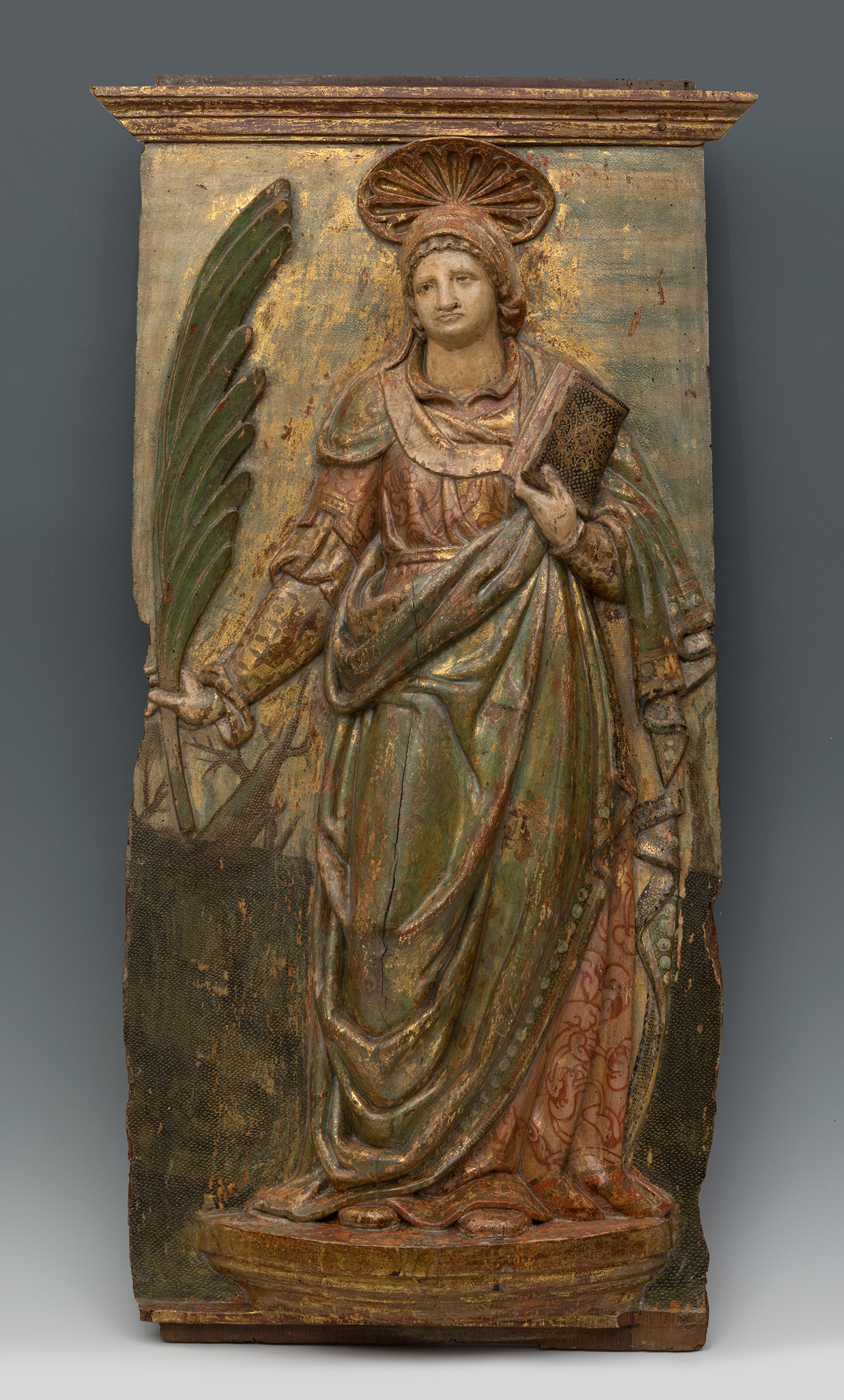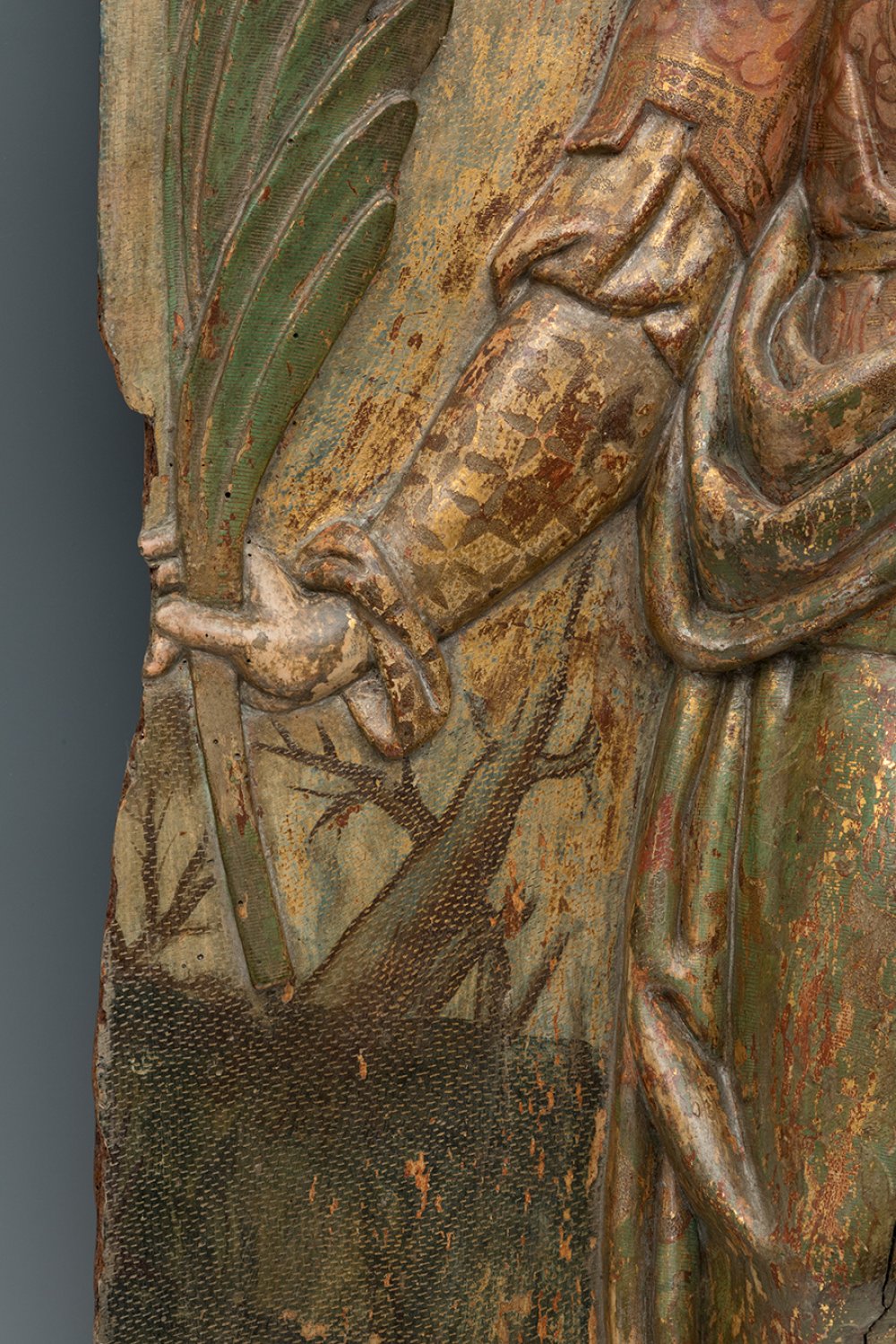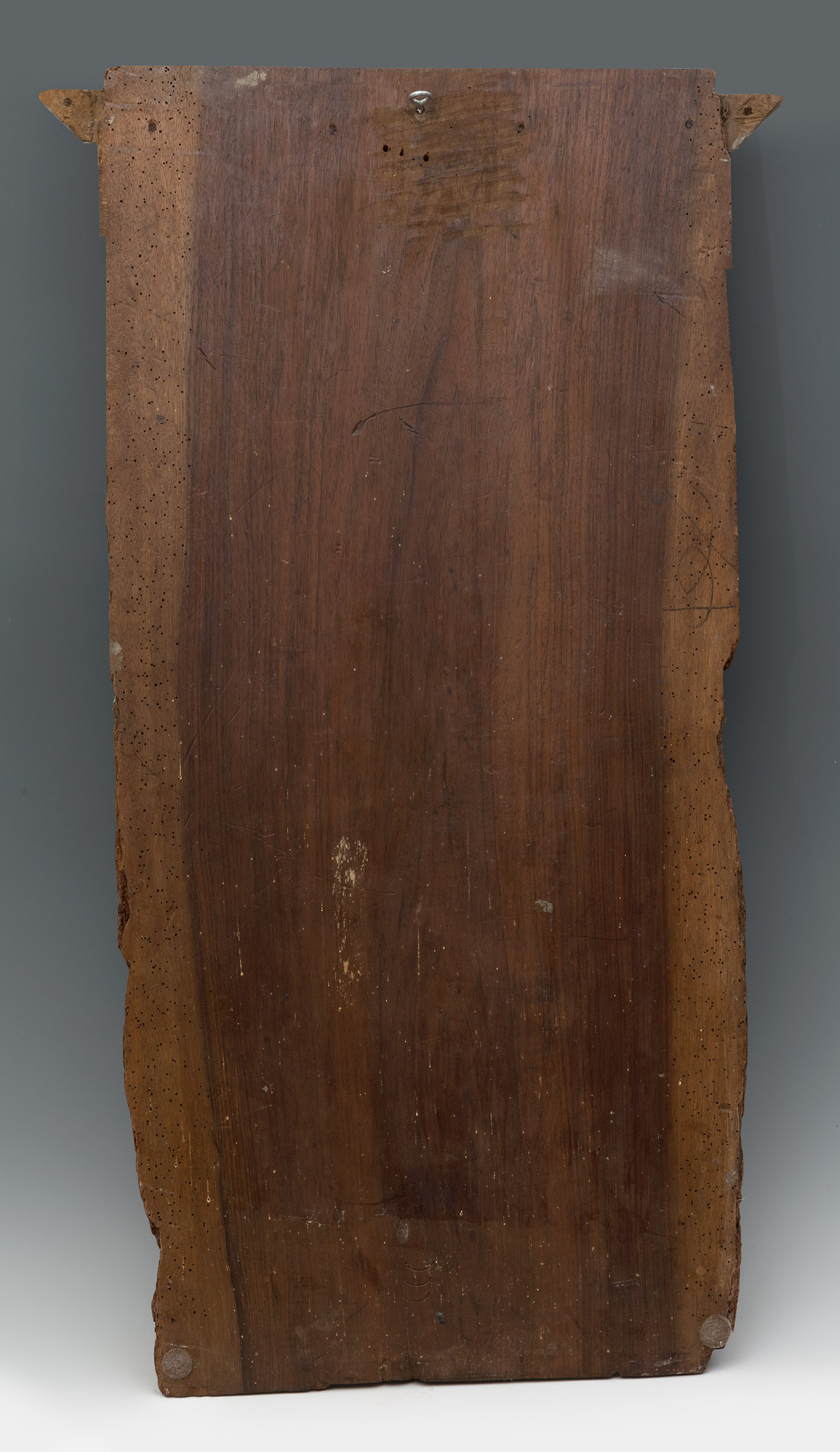9
Spanish Renaissance school of the 16th century."Catherine of Alexandria".Measurements: 99,5 x 56
"Catherine of Alexandria".
Measurements: 99,5 x 56 cm.
Spain was, at the beginning of the 16th century, the European nation best prepared to receive the new humanist concepts of life and art due to its spiritual, political and economic conditions, although from the point of view of plastic forms, its adaptation of those introduced by Italy was slower due to the need to learn the new techniques and to change the taste of the clientele. Sculpture reflects perhaps better than other artistic fields this desire to return to the classical Greco-Roman world, which exalts in its nudes the individuality of man, creating a new style whose vitality surpasses mere copying. Anatomy, the movement of the figures, compositions with a sense of perspective and balance, the naturalistic play of folds, the classical attitudes of the figures soon began to be valued; but the strong Gothic tradition maintained expressiveness as a vehicle for the profound spiritualist sense that informs our best Renaissance sculptures. This strong and healthy tradition favours the continuity of religious sculpture in polychrome wood, which accepts the formal beauty offered by Italian Renaissance art with a sense of balance that avoids its predominance over the immaterial content that animates the forms. In the early years of the century, Italian works arrived in our lands and some of our sculptors went to Italy, where they learned first-hand the new standards in the most progressive centres of Italian art, whether in Florence or Rome, and even in Naples. On their return, the best of them, such as Berruguete, Diego de Siloe and Ordóñez, revolutionised Spanish sculpture through Castilian sculpture, even advancing the new mannerist, intellectualised and abstract derivation of the Italian Cinquecento, almost at the same time as it was being produced in Italy.
A fourth-century Christian martyr, Catherine came from a noble family in Alexandria. Gifted with a great intelligence, she soon stood out for her extensive studies, which placed her on the same level as the greatest poets and philosophers of the time. One night Christ appeared to her and she decided to consecrate her life to him, considering herself his fiancée from then on. She refused to marry the emperor Maximian, and victoriously held a dispute with fifty philosophers sent by him to prove to him the inanity of the Christian faith. Furious, Maximian condemned her to be torn apart by a spiked wheel. The wheel miraculously breaks, and Catherine is finally beheaded. Her iconography is extensive, including the wheel and the sword of her martyrdom, the book symbolising her wisdom, the palm alluding to the victory of martyrdom and the lily as a sign of her virginity. However, one of the most frequent iconographic elements in her representation is the severed head of Caesar Maximinus, which allegorically represents the saint's triumph over the pagan tyrant.
"Catherine of Alexandria".
Measurements: 99,5 x 56 cm.
Spain was, at the beginning of the 16th century, the European nation best prepared to receive the new humanist concepts of life and art due to its spiritual, political and economic conditions, although from the point of view of plastic forms, its adaptation of those introduced by Italy was slower due to the need to learn the new techniques and to change the taste of the clientele. Sculpture reflects perhaps better than other artistic fields this desire to return to the classical Greco-Roman world, which exalts in its nudes the individuality of man, creating a new style whose vitality surpasses mere copying. Anatomy, the movement of the figures, compositions with a sense of perspective and balance, the naturalistic play of folds, the classical attitudes of the figures soon began to be valued; but the strong Gothic tradition maintained expressiveness as a vehicle for the profound spiritualist sense that informs our best Renaissance sculptures. This strong and healthy tradition favours the continuity of religious sculpture in polychrome wood, which accepts the formal beauty offered by Italian Renaissance art with a sense of balance that avoids its predominance over the immaterial content that animates the forms. In the early years of the century, Italian works arrived in our lands and some of our sculptors went to Italy, where they learned first-hand the new standards in the most progressive centres of Italian art, whether in Florence or Rome, and even in Naples. On their return, the best of them, such as Berruguete, Diego de Siloe and Ordóñez, revolutionised Spanish sculpture through Castilian sculpture, even advancing the new mannerist, intellectualised and abstract derivation of the Italian Cinquecento, almost at the same time as it was being produced in Italy.
A fourth-century Christian martyr, Catherine came from a noble family in Alexandria. Gifted with a great intelligence, she soon stood out for her extensive studies, which placed her on the same level as the greatest poets and philosophers of the time. One night Christ appeared to her and she decided to consecrate her life to him, considering herself his fiancée from then on. She refused to marry the emperor Maximian, and victoriously held a dispute with fifty philosophers sent by him to prove to him the inanity of the Christian faith. Furious, Maximian condemned her to be torn apart by a spiked wheel. The wheel miraculously breaks, and Catherine is finally beheaded. Her iconography is extensive, including the wheel and the sword of her martyrdom, the book symbolising her wisdom, the palm alluding to the victory of martyrdom and the lily as a sign of her virginity. However, one of the most frequent iconographic elements in her representation is the severed head of Caesar Maximinus, which allegorically represents the saint's triumph over the pagan tyrant.
7th September - Old Masters
Sale Date(s)
Venue Address
General delivery information available from the auctioneer
Setdart offers Worldwide shipping
PICK UP IN ROOM: You can come and pick up your lots in our offices (Barcelona, Madrid or Valencia). At the moment of the withdrawal, you will be able to accept the current conditions of the lot by means of a document that you will sign.
YOU CAN SEND ANOTHER PERSON TO PICK UP: This person must present a signed authorization that you can find in our web page by accessing from BUY AT SETDART- LOGISTICS-DOWNLOAD AUTHORIZATION DOCUMENT. You can also send an e-mail with the requested data in AUTHORIZATION DOCUMENT to admin@setdart.com
Important Information
25% buyer´s premium
21% buyer´s premium at www.setdart.com
Terms & Conditions
The maximum period to pay the lots is 7 working days. You can pay either via bank transfer or with credit card through our platform www.setdart.com (we only accept VISA or Mastercard).
BUYER´S PREMIUM: 22% Hammer price + 21% VAT from the buyer´s premium
If your piece has more than 100 years, our Ministry of Culture requires an export certificate in order for the piece to leave the country. Note that if the piece goes inside the EU, there is no cost for the export certificate. If the piece goes outside the EU, there is a cost for the export certificate. You can find more information in our Ministry of Culture website: https://www.culturaydeporte.gob.es/en/cultura/patrimonio/exportacionimportacion/exportacion/tasas.html
INQUIRIES: admin@setdart.com
Setdart guides you through the entire process, from the time of award to the day you receive your lot. Our logistics team will be happy to manage your transport, and will advise you on the best shipping method with professionals from the sector used to handling works of art and jewelry.
WE OFFER WORLDWIDE DOOR TO DOOR SHIPPING
PICK UP IN ROOM: You can come and pick up your lots in our offices. At the moment of the withdrawal, you will be able to accept the current conditions of the lot by means of a document that you will sign.
YOU CAN SEND ANOTHER PERSON TO PICK UP: This person must present a signed authorization that you can find in our web page by accessing from BUY AT SETDART-LOGISTICS-DOWNLOAD AUTHORIZATION DOCUMENT. You can also send an e-mail with the requested data in AUTHORIZATION DOCUMENT to admin@setdart.com
SETDART IS NOT RESPONSIBLE FOR THE STATE OF THE PARTS ONCE THEY LEAVE OUR FACILITIES. MRW SHIPMENTS: Once the payment is made, your lot will be packed for shipment, the logistics department will send you an e-mail notifying you of the day it leaves our warehouse, changes of address cannot be made after receiving this e-mail.
INSURANCE INCIDENTS: Coverage for the value of the auction up to 3000 ? per shipment, if the value of the auction is higher, Setdart will send you a quote including the additional insurance. The insurance company WILL NOT BE RESPONSIBLE FOR THE SHIPMENT THAT EXCEEDS THAT AMOUNT AND IS NOT FULLY INSURED. MRW INCIDENTS: Maximum notification 48 hours after receipt, after which the insurance company WILL NOT BE RESPONSIBLE AND NO CLAIMS WILL BE ACCEPTED.
E-MAIL LOGISTICS: logistica@setdart.com
PICK UP YOUR MESSAGES: You can send your own messaging, prior notice via e-mail that your shipment is ready, please note 3 or 4 days in advance. This type of shipment is packaged so Setdart will provide you with a quote.
EXPENSES FOR STORAGE: We inform you that if the purchased lot is not picked up within a month, you will be charged 30€ per week per lot. Setdart Online S.L., owner of the web site "setdart.com", "setdart.net" and "setdart.org", acts as a company of Spanish nationality inscribed in the Volume 36955, sheet 182, page B-293056 of the Mercantile Registry, with registered office at Calle Aragó












